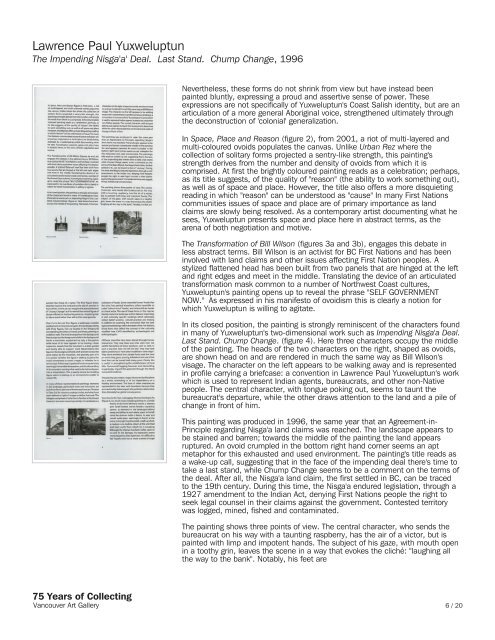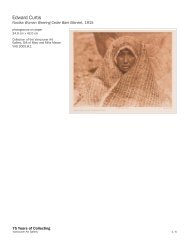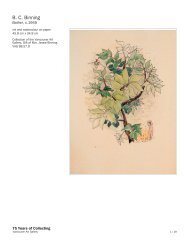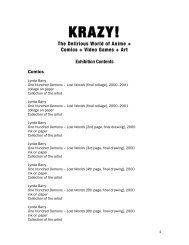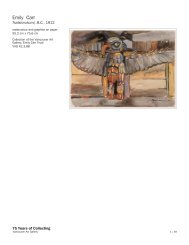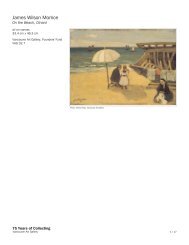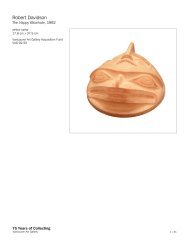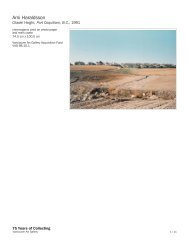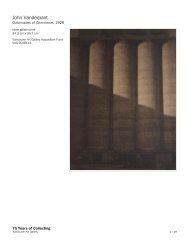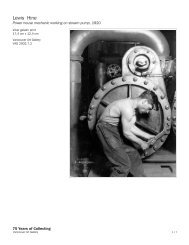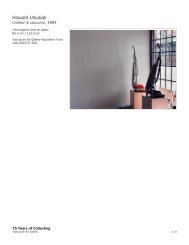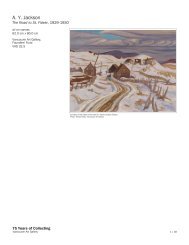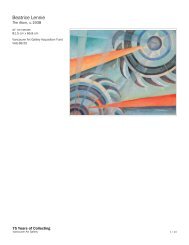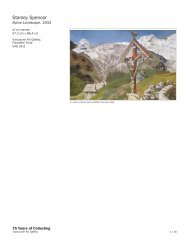Lawrence Paul Yuxweluptun - 75 Years of Collecting - Vancouver ...
Lawrence Paul Yuxweluptun - 75 Years of Collecting - Vancouver ...
Lawrence Paul Yuxweluptun - 75 Years of Collecting - Vancouver ...
You also want an ePaper? Increase the reach of your titles
YUMPU automatically turns print PDFs into web optimized ePapers that Google loves.
<strong>Lawrence</strong> <strong>Paul</strong> <strong>Yuxweluptun</strong><br />
The Impending Nisga'a' Deal. Last Stand. Chump Change, 1996<br />
<strong>75</strong> <strong>Years</strong> <strong>of</strong> <strong>Collecting</strong><br />
<strong>Vancouver</strong> Art Gallery<br />
Nevertheless, these forms do not shrink from view but have instead been<br />
painted bluntly, expressing a proud and assertive sense <strong>of</strong> power. These<br />
expressions are not specifically <strong>of</strong> <strong>Yuxweluptun</strong>'s Coast Salish identity, but are an<br />
articulation <strong>of</strong> a more general Aboriginal voice, strengthened ultimately through<br />
the deconstruction <strong>of</strong> 'colonial' generalization.<br />
In Space, Place and Reason (figure 2), from 2001, a riot <strong>of</strong> multi-layered and<br />
multi-coloured ovoids populates the canvas. Unlike Urban Rez where the<br />
collection <strong>of</strong> solitary forms projected a sentry-like strength, this painting's<br />
strength derives from the number and density <strong>of</strong> ovoids from which it is<br />
comprised. At first the brightly coloured painting reads as a celebration; perhaps,<br />
as its title suggests, <strong>of</strong> the quality <strong>of</strong> "reason" (the ability to work something out),<br />
as well as <strong>of</strong> space and place. However, the title also <strong>of</strong>fers a more disquieting<br />
reading in which "reason" can be understood as "cause" In many First Nations<br />
communities issues <strong>of</strong> space and place are <strong>of</strong> primary importance as land<br />
claims are slowly being resolved. As a contemporary artist documenting what he<br />
sees, <strong>Yuxweluptun</strong> presents space and place here in abstract terms, as the<br />
arena <strong>of</strong> both negotiation and motive.<br />
The Transformation <strong>of</strong> Bill Wilson (figures 3a and 3b), engages this debate in<br />
less abstract terms. Bill Wilson is an activist for BC First Nations and has been<br />
involved with land claims and other issues affecting First Nation peoples. A<br />
stylized flattened head has been built from two panels that are hinged at the left<br />
and right edges and meet in the middle. Translating the device <strong>of</strong> an articulated<br />
transformation mask common to a number <strong>of</strong> Northwest Coast cultures,<br />
<strong>Yuxweluptun</strong>'s painting opens up to reveal the phrase "SELF GOVERNMENT<br />
NOW." As expressed in his manifesto <strong>of</strong> ovoidism this is clearly a notion for<br />
which <strong>Yuxweluptun</strong> is willing to agitate.<br />
In its closed position, the painting is strongly reminiscent <strong>of</strong> the characters found<br />
in many <strong>of</strong> <strong>Yuxweluptun</strong>'s two-dimensional work such as Impending Nisga'a Deal.<br />
Last Stand. Chump Change. (figure 4). Here three characters occupy the middle<br />
<strong>of</strong> the painting. The heads <strong>of</strong> the two characters on the right, shaped as ovoids,<br />
are shown head on and are rendered in much the same way as Bill Wilson's<br />
visage. The character on the left appears to be walking away and is represented<br />
in pr<strong>of</strong>ile carrying a briefcase: a convention in <strong>Lawrence</strong> <strong>Paul</strong> <strong>Yuxweluptun</strong>'s work<br />
which is used to represent Indian agents, bureaucrats, and other non-Native<br />
people. The central character, with tongue poking out, seems to taunt the<br />
bureaucrat's departure, while the other draws attention to the land and a pile <strong>of</strong><br />
change in front <strong>of</strong> him.<br />
This painting was produced in 1996, the same year that an Agreement-in-<br />
Principle regarding Nisga'a land claims was reached. The landscape appears to<br />
be stained and barren; towards the middle <strong>of</strong> the painting the land appears<br />
ruptured. An ovoid crumpled in the bottom right hand corner seems an apt<br />
metaphor for this exhausted and used environment. The painting's title reads as<br />
a wake-up call, suggesting that in the face <strong>of</strong> the impending deal there's time to<br />
take a last stand, while Chump Change seems to be a comment on the terms <strong>of</strong><br />
the deal. After all, the Nisga'a land claim, the first settled in BC, can be traced<br />
to the 19th century. During this time, the Nisga'a endured legislation, through a<br />
1927 amendment to the Indian Act, denying First Nations people the right to<br />
seek legal counsel in their claims against the government. Contested territory<br />
was logged, mined, fished and contaminated.<br />
The painting shows three points <strong>of</strong> view. The central character, who sends the<br />
bureaucrat on his way with a taunting raspberry, has the air <strong>of</strong> a victor, but is<br />
painted with limp and impotent hands. The subject <strong>of</strong> his gaze, with mouth open<br />
in a toothy grin, leaves the scene in a way that evokes the cliché: "laughing all<br />
the way to the bank". Notably, his feet are<br />
6 / 20


